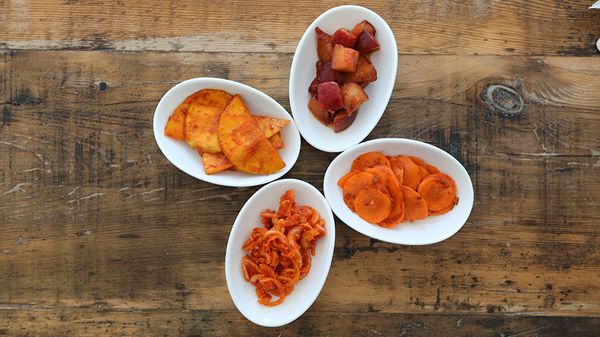2 simple recipes for making sharp and spicy achar (aka Indian pickles)
Achar, also known as Indian pickles, have been a part of India’s culture and history for 4,000 years. I would argue that the technique of pickling originated in India; the process is as ancient as our civilization. People first started salting and curing food in brines to preserve it for long journeys.
The ingredients that make up achar can be both simple and seasonal. All Indians have dozens of pickles at their disposal: assorted or mixed pickles, lime, chili, gooseberry — the list goes on. Yet, no pickle is loved by Indians more than mango, the most famous among the lot. It all begins with raw mangoes at their peak, chosen for tartness and firmness, with each region touting their variety of mangoes and recipe as the best.
Opening a jar of pickles is universally euphoric. First, the aromas of the spices lure me back to childhood. Shortly after, I smell the fiery peppers, and the bright red and green-colored fruit peeks out of the mixture.
Mango is served at every meal and is always a trusted sidekick of India’s most notorious rice dish called Hyderabadi biryani. Traditionally, Indian meals combine a small piece of a pickle with each bite of food. (Some people prefer mixing in some pickles — especially the oil — with plain rice.) Whichever way you eat your pickles, the joy is in mixing the tangy and spicy flavors together.
I’ve seen kimchi — a delicious South Korea dish made of cabbage, radish and other vegetables — on nearly every menu from brunch to lunch to dinner. It’s almost impossible to dine out in New York and other popular food destinations without seeing a pickled element on each dish. And it’s easy to understand why: We often want something sharp and spicy to complement the subtle flavor of the primary serving. That’s where pickles — or lately kimchi — have played an important role in satisfying our taste buds. I should note there are thousands of varieties of pickles used in cuisines around the world.
 Chef Palak’s pickled carrots, mango, onion and plum (Image courtesy of the Institute of Culinary Education)
Chef Palak’s pickled carrots, mango, onion and plum (Image courtesy of the Institute of Culinary Education)
As quintessential as salt and pepper are to the American table, achar has graced my family’s table for generations. I was inspired to build on that tradition and put my pickling knowledge to use with locally sourced vegetables. Chef Chris Scott and I tested four varieties of pickles ranging from sweet and sour to fiery and bold. The humble pickled onion, sliced on a mandolin, and dried garlic kicked off the lineup with copious amounts of salt, chili, sugar and vinegar. Then we got a more adventurous with carrots, matching the sweetness with some sugar, using dried fenugreek and coriander seeds roasted and ground to a powder, a touch of hing (a spice commonly used in Indian cooking) and oil infused with black mustard seeds.
The real experimenting began when I wondered if I could make tandoori-pickled butternut squash. The short answer — yes, and a craveable creation it was. Last but not least, a sweet and savory ending with plums coated with dried Omani limes (a traditional ingredient in Middle Eastern cooking), sugar and chilies from India and Korea. This might have been our accidental discovery because the tartness and flavors of dried lime played so well with the sweet fruit. The beauty of pickle-making is a time-tested process that is quite forgiving for beginners.
So the next time you want to enjoy pickles as you have at your favorite Indian restaurant or impress your friends with an authentic creation in the kitchen, just think of a vegetable or a fruit, rummage your cabinet for spices, add a touch of salt, oil and vinegar — and violà, you have pickles. Almost all of these pickles can be kept refrigerated for two weeks in airtight containers.
***
Recipe: Pickled Carrots
Ingredients
- 1 large carrot, peeled
- 1 teaspoon salt
- 1/2 teaspoon red chili powder
- 1/2 teaspoon lemon juice
- 1 teaspoon sugar
- 1 teaspoon fenugreek powder (optional)
- 3 tablespoons mustard oil
- 1/2 teaspoon black mustard seeds
- 1 pinch asafoetida
Directions
- Slice carrot thinly on a mandolin, place in a bowl.
- Add salt, red chili powder, lemon juice, sugar and optional fenugreek powder to the bowl. Set aside for 30 minutes.
- Heat mustard oil on medium-high, add mustard seeds and asafoetida.
- Remove oil from heat and cool.
- Pour over carrots and stir.
- Place pickles in a clean glass jar. Store in the refrigerator for a week.
Recipe: Pickled Plums
Ingredients
- 1 whole dried omani lime (will yield 1/4 teaspoon dried powder)
- 4 plums, cut in 1-inch cubes
- 2 tablespoons salt
- 1/2 teaspoon cayenne powder
- 1 teaspoon white wine vinegar
- 2 tablespoons sugar
Directions
- In a small pan heat lime lightly. Pulse to powder in a spice grinder.
- Place plums in a large bowl and add salt, cayenne powder, vinegar, dried lime powder and sugar. Set aside for 30 minutes.
- Place plums in a clean glass jar. Store in the refrigerator for a week.

